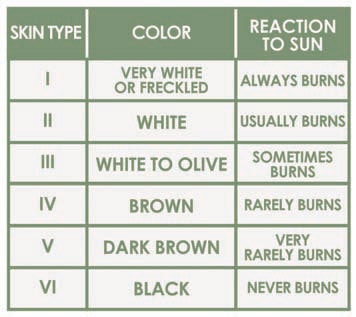Much of the world’s population is considered Fitzpatrick type IV–VI. (See Fitzpatrick Scale.) By 2050, according to the U.S. Census Bureau in 2000, 50% of Americans will be of dark-skinned racial backgrounds. One of the most common skin conditions in higher Fitzpatrick clients is hyperpigmentation. Although many of the popular treatments and products designed for Caucasians may be well-tolerated by consumers with dark skin, a deeper understanding of the causes of hyperpigmentation, and of the myriad of ingredients available for its treatment, will help brand owners develop effective product lines for these target markets, regardless of ethnicity.
Beyond Black and White
Within any ethnic background, a variety of Fitzpatrick skin types can be identified. With this broad global representation in mind, brand owners can expect to see an increase in consumers of one or mixed racial backgrounds with dark skin.
The most apparent difference in the skin of those from different ethnicities is, of course, the color, although there are also differences in skin thickness, vascularity, and predispositions to certain skin conditions and diseases. Hyperpigmentation can occur due to UV exposure, cutaneous trauma or hormonal fluctuations. Studies by dermatologist Susan Taylor in 2005 demonstrate that up to 86% of women of Latino, Asian and African descent are concerned about skin discolorations.1
Melanogenesis and Skin Color
Melanin is the complex molecule that is responsible for the pigment in the body—specifically eyes, hair and skin. Melanin works to protect by reducing the penetration of UV rays into the skin and, even more importantly, into the nuclei of cells where DNA resides. Both dark and light skin individuals have the same number of melanocytes—the cells responsible for melanogenesis or melanin production—although their level of responsiveness differs.
Those whose genetic heredity is that of global regions with extreme UV exposure have melanocytes that will, out of protective necessity, instigate the process of melanin deposition much more quickly than someone with lighter skin. Some people with mixed genetic heritage may have lighter skin but still have a greater predisposition for hyperpigmentation than a typical Fitzpatrick skin type I or II.
As a result of inflammation or hormonal fluctuations, the following process is stimulated. Melanocyte stimulating hormone (MSH) is triggered and released. Within the melanocyte, a chain of events is activated that begins with the enzyme tyrosinase being released from the rough endoplasmic reticulum (RER) and acting on the amino acid tyrosine to convert it to L-DOPA (another amino acid). Then, tyrosinase binds with copper and acts on L-DOPA, converting it into melanosomes.
These melanosomes are packets of pigment that can either be eumelanin (brown/black pigment) or pheomelanin (orange/red pigment). Dark skin tends to have more eumelanin. This more vigorous type of melanin contributes to the increased occurrence of hyperpigmentation in dark skin.
Those with fairer skin will predominantly have pheomelanin. The final color of a person’s skin will be slightly different based on the ratio of eumelanin to pheomelanin, as well as the quantity of sustained UV exposure to which their skin is subjected. The melanosomes produced are then transported along the dendrites, or arms, of the melanocyte and transferred into the keratinocyte. They congregate in an umbrella like pattern over the nucleus to protect the DNA within the cell, resulting in visible hyperpigmentation. Protease-activated receptor-2 (PAR-2) is the receptor located in the keratinocytes that regulates whether or not the melanosomes that arrive at the keratinocyte are phagocytized—consumed or taken in. The keratinocytes in skin of color contain more of these PAR-2 receptors, increasing the amount of phagocytized melanosomes by keratinocytes.
Additionally, PAR-2 receptors are increased in number by UV exposure, which may explain the predisposition of dark skin to be more responsive to melanogenesis. All types of hyperpigmentation can affect any person, regardless of race, although this PAR-2 expression and upregulation makes it more prevalent in those with dark skin.
Gentle Treatment Options
Many of the ingredients that are used to treat hyperpigmentation can be topically irritating. Therefore, ingredients must be selected with care when creating products for consumers with dark skin to avoid causing undue irritation that will worsen the condition rather than improve it.
To avoid stimulating pigment deposition, it is wise to use lower percentages of ingredients in blends to prevent melanogenesis, rather than one ingredient at a high percentage that could potentially be surface-stimulating. See Melanogenesis Inhibitors to identify which ingredients to look for when creating products for Fitzpatrick skin types IV–VI.
Prevention
One of the most important steps in any skin care regimen is that of sun protection. Although dark skin has more natural protection against UV exposure, this critical step cannot be omitted. With an understanding of the more reactive state of the melanocytes in people with dark skin—along with blends of gentle, beneficial melanogenesis-inhibiting ingredients—great success can be achieved in developing products for Fitzpatrick type IV–VI consumers.
References
- test.neton-line.com/EMAIL/eNewsletters/Public/0207.html (Accessed Jan 27, 2011)
- S Badreshia-Bansal and ZD Draelos, Insight into Skin Lightening Cosmeceuticals for Women of Color, J of Drugs in Dermatology 6 1 32–39 (2007)
Editor’s note: This article originally ran in the September 2010 issue of Skin Inc. magazine. All rights reserved.
Scottsdale, AZ-based dermatologist Jennifer Linder, MD, is the chief scientific officer for PCA Skin.











